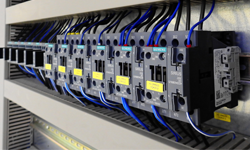Buy the standard
BS EN 60898-1:2019, Electrical accessories – Circuit-breakers for overcurrent protection for household and similar installations – Part 1: Circuit-breakers for a.c. operation,
Members get 50% off

Making excellence a habit
Published date: |
|
Modified date: |
|
 In the late 1960s around 700 people per year died in house fires in the UK.[1] That figure is now down to less than 400 people per year, despite the increase in population over that time.[2] A government survey in 2016–17 found that 1% of households in England had a fire of some sort at home in the previous 2 years.
In the late 1960s around 700 people per year died in house fires in the UK.[1] That figure is now down to less than 400 people per year, despite the increase in population over that time.[2] A government survey in 2016–17 found that 1% of households in England had a fire of some sort at home in the previous 2 years.
What has led to this improvement in fire safety? It is a host of factors, including reliable modern smoke alarms, improved regulation of rented housing, better-quality electrical appliances, less smoking and improved public awareness. There's another unsung hero in this mix of factors, however: the simple circuit-breaker.
A circuit-breaker responds to abnormal conditions in an electrical circuit – for example an excessive increase in current flow – by breaking the circuit. The mechanism is similar to a fuse, but whereas a fuse is permanently blown, circuit-breakers can be closed again to allow normal operation to recommence.
The main causes of a circuit-breaker being triggered are overloading, when the system attempts to carry a greater electrical current than was intended, and a short circuit, caused by a wiring problem such as two wires touching.[3]
Circuit-breakers help to prevent such dangers as electric shocks and fires. Each year house fires cause around 2,500 injuries and over £100m in property damage as well as almost 50 deaths. Faulty electrical appliances are responsible for £41.6m in damage, with electric cookers and lighting being the most common causes (£24m and £13m in damage, respectively).[4]
It is of immense value for everyone, from consumers to manufacturers and regulators, to have a set of written expectations setting out how a circuit-breaker should perform. The standard BS EN 60898-1:2019, Electrical accessories – Circuit-breakers for overcurrent protection for household and similar installations – Part 1: Circuit-breakers for a.c. operation, provides such a guide.
The standard implements EN 60898-1:2019 in the UK. It is derived from IEC 6098-1:2015 and modified by CENELEC. It supersedes BS EN 60898‑1:2003+A13:2012, which will be withdrawn on 18 January 2024. This edition of the standard introduces important changes from its predecessor – specifically regarding device terminals – and includes a revision of the glow-wire test and simplification of the figures showing short circuit tests.
The standard is an important source of information about circuit-breakers. For example, it contains a list of the characteristics of circuit-breakers. These include details of how the mechanism should work, clearances and creepage distances, screws, current-carrying parts and connections, terminals for external conductors, non-interchangeability, mechanical mounting of plug-in-type circuit-breakers and protection against electric shock.
One of the aims of the standard is to describe conditions that circuit-breakers must comply with – for example how they should behave under normal service, what should happen in case of an overload, and their operation and behaviour in case of short circuits up to their rated short-circuit capacity.
The standard provides detailed information in the format of easy-to-use tables. For example, one covers the standard values of rated voltage for single-pole, two-pole, three-pole and four-pole circuit-breakers. The table gives rated voltages for use as well as details of the circuit supplying the circuit-breaker.
There is also a guide to marking and other product information. A circuit-breaker should be marked in a durable manner with details such as the manufacturer's name or trademark; type designation, catalogue number or serial number; and rated voltage, current, frequency and short-circuit capacity. It sets out requirements for elements such as the opening operation for circuit-breakers operated by means of two push-buttons. Only the push-button designed for the opening operation should be red and/or be marked with the symbol O.
A handy table for marking details all the various requirements that can be applied to circuit-breakers, showing where different markings may be printed or displayed. Some markings may be placed so they are visible only before the device is installed.
The standard also sets out the ways that circuit-breakers can be tested for problems. These include indelibility of marking; reliability of screws, current-carrying parts and connections; reliability of terminals for external conductors; protection against electric shock; dielectric properties and isolating capability; temperature rise; and mechanical and electrical endurance.
The tests are described in clear language, giving all the information needed to carry out tests, with diagrams showing test apparatus and layouts.
Standards have played an invaluable role in achieving improvement in fire and electrical safety. They enable us to reduce risk and ensure that best practice is applied. Why not think about standards the next time you flick a switch in your home.
BS EN 60898-1:2019, Electrical accessories – Circuit-breakers for overcurrent protection for household and similar installations – Part 1: Circuit-breakers for a.c. operation,
Members get 50% off